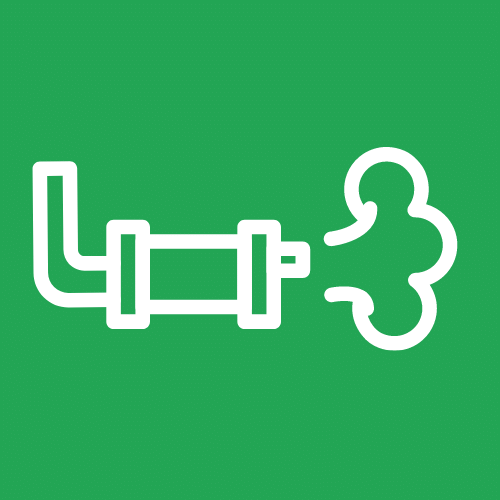WHAT IS A DPF?

Legal Requirement? | DPF Warning Light? | DPF Regeneration?
- A diesel particulate filter (DPF) is a device which sits in the exhaust system, it “captures” soot / diesel particulate and other nasty particles so they are not released into atmosphere. A diesel particulate filter can remove upwards of 85% of the particles from the exhaust, reducing harmful emissions.
- The DPF physically captures the soot and ash particles in a net or mesh like structure within the filter.
- DPFs have been in common use in passenger cars and light commercials from around 2003 in preparation for Euro 4 regs (2005), with Peugeot, Renault and BMW being early takers. Euro 5 (2009) made it compulsory for diesel cars and light commercials to have a DPF fitted and Euro 6 2014 will tighten this up further.
- Two types of particulate filter are in used – those with additive and those without. To enable a vehicle to use a system without additive the particulate filter must be fitted close to the engine. Because the exhaust gases will not have travelled far from the engine they will still be hot enough to burn off the carbon soot particles. In these systems an oxidising catalytic converter will be integrated into the particulate filter. In other systems the particulate filter is fitted some distance from the engine and as the exhaust gases travel along the exhaust they cool. The temperatures required for ignition of the exhaust gas can only be achieved by the use of an additive.
- Diesel Particulate Filters are made of a porous ceramic honeycomb of alternate end closed channels. The exhaust gas enters the DPF and passes through the porous walls of these channels and traps the particulate matter.
- Particulate matter (or PM) in the DPF is made up of soot and ash. Soot is normally removed from the DPF through regeneration, but leaving the ash behind in the channels.
- In some cases, ash bridging may also occur causing blockages to form near the middle of the filter, effectively blocking flow through the remainder of the channel.
- Ash, by definition is incombustible and must be removed from the DPF through an effective cleaning process.
- Ash build-up is the primary reason for premature DPF failure and is the most important factor controlling the service life of the filter.
- Ash and soot accumulation restricts exhaust flow, therefore increasing back pressure, making it harder for the engine to breathe. This can greatly affect performance and fuel consumption.
- When the filter is blocked, options such as forced regeneration or chemical additives will only remove some of the soot, but not the ash.
- If high ash levels remain, this will, at best, only be a short-term solution and therefore a potential waste of time and money.
- DPF’s can be restored to virtually new condition by thorough cleaning, removing both soot and ash, as well as recovering DPF’s with oil and coolant contamination.
- From February 2014 the inspection of the exhaust system carried out during the MoT test will include a check for the presence of a DPF.
- A missing DPF, where one was fitted when the vehicle was built, will result in an MoT failure. A vehicle might still pass the MoT visible smoke emissions test, which is primarily intended to identify vehicles that are in a very poor state of repair, whilst emitting illegal and harmful levels of fine exhaust particulate. It is an offence under the Road vehicles (Construction and Use) Regulations (Regulation 61a(3))1 to use a vehicle which has been modified in such a way that it no longer complies with the air pollutant emissions standards it was designed to meet.
- Removal of a DPF will almost invariably contravene these requirements, making the vehicle illegal for road use. The potential penalties for failing to comply are fines of up to £1,000 for a car or £2,500 for a light goods vehicle.

Are you having problems with your DPF?

DPF or Anti-Pollution warning lights on your dash?

Car in “limp home” safety mode?

Poor acceleration and MPG?

Facing expensive repair costs to replace the DPF?

Confused what the best solution is for you?Are you having problems with your DPF?
DOES MY VEHICLE HAVE A DPF FITTED?


UK emissions standards for cars effectively required fitment of a DPF in the exhaust of diesel cars in 2009 when the ‘Euro 5′ standard came into force. Many cars before this time already had one fitted in anticipation of this requirement but its generally accepted that very few diesel cars manufactured before 2006 had a diesel particulate filter fitted.

If you are in any doubt, the unit should be visible if you have under the vehicle. They are normally located to the front of the exhaust system. If you’re not mechanically minded then it may be beneficial to take along a mechanic if you are looking to buy a car but are keen to avoid having a DPF.
DPF REGENERATION
Regeneration is the process of removing the accumulated soot from the filter. This is done either passively (from the engine’s exhaust heat in normal operation or by adding a catalyst to the filter) or actively introducing very high heat into the exhaust system. On-board active filter management can use a variety of strategies:
- Engine management to increase exhaust temperature through late fuel injection or injection during the exhaust stroke
- Use of a fuel borne catalyst to reduce soot burn-out temperature
- A fuel burner after the turbo to increase the exhaust temperature
- A catalytic oxidizer to increase the exhaust temperature, with after injection (HC-Doser)
- Resistive heating coils to increase the exhaust temperature
- Microwave energy to increase the particulate temperature
All on-board active systems use extra fuel, whether through burning to heat the DPF, or providing extra power to the DPF’s electrical system, although the use of a fuel borne catalyst reduces the energy required very significantly.
Typically a computer monitors one or more sensors that measure back pressure and/or temperature, and based on pre-programmed set points the computer makes decisions on when to activate the regeneration cycle. The additional fuel can be supplied by a metering pump. Running the cycle too often while keeping the back pressure in the exhaust system low will result in high fuel consumption. Not running the regeneration cycle soon enough increases the risk of engine damage and/or uncontrolled regeneration (thermal runaway) and possible DPF failure.
Diesel particulate matter burns when temperatures above 600 degrees Celsius are attained. This temperature can be reduced to somewhere in the range of 350 to 450 degrees Celsius by use of a fuel borne catalyst. The actual temperature of soot burn-out will depend on the chemistry employed. The start of combustion causes a further increase in temperature. In some cases, in the absence of a fuel borne catalyst, the combustion of the particulate matter can raise temperatures above the structural integrity threshold of the filter material, which can cause catastrophic failure of the substrate. Various strategies have been developed to limit this possibility. Note that unlike a spark-ignited engine, which typically has less than 0.5% oxygen in the exhaust gas stream before the emission control device(s), diesel engines have a very high ratio of oxygen available. While the amount of available oxygen makes fast regeneration of a filter possible, it also contributes to runaway regeneration problem
WHAT DOES THE DPF WARNING LIGHT MEAN?


The DPF warning light displayed on the dash board indicates that the filter is not working correctly or is in need of maintenance / regeneration. Sensors within the device or the exhaust monitor the back pressure and temperature of the system to ensure its working correctly. When the readings from this sensors are outside a preprogrammed limit this will trigger the warning.

Once activated, the light should trigger a regeneration of the filter or could indicate that the device is faulty and in need of replacement or repair.
PROBLEMS ENCOUNTERED WITH DPF
- If regeneration doesn’t function properly it leads to a build-up of soot affecting performance and fuel economy, left unattended this will result in a Blocked DPF which can ultimately cause very expensive damage to other engine components. A blocked DPF is also potentially dangerous as it can cause overheating in the exhaust system and cause a fire risk. To prevent this damage most new vehicles will go into “Limp Home” safety mode at this stage, meaning the vehicle will have minimum power barely sufficient to crawl home.
- For regeneration to take place it requires the vehicle to be driven regularly at some speed on open roads e.g. motorway driving, typically driving at around 2500 RPM for approx. 15-30mins at least once a month, this will keep things working.
- Many diesel vehicles are used primarily in urban areas or on short stop start journeys e.g. local deliveries, taxi’s, school runs etc and many have auto gearbox, so the vehicle does not get the chance to heat up sufficiently and is unable to carry out a full regeneration process.
- Even if the regeneration functions as it should, over time the Ash Residue will build up in the DPF and have the same affect ultimately resulting in a blocked DPF. For this reason a DPF is classified as a Serviceable Item by the vehicle manufacturers like brake pads or air filters etc and not covered under warranty. DPF systems therefore need to be maintained properly.
WHAT ELSE SHOULD I BE AWARE OF?
- It is often said that you should “go for a blast” down the motorway to clear the DPF. Please note this is only partially true. If the DPF is blocked beyond the capacity for regeneration or blocked due to Ash residue, you will do more harm to your engine.
- There are many DPF cleaning additives available promising a magic cure for DPF. We have yet to find one that will clear a blocked filter and will certainly not clear an Ash blocked filter. Some products can however be useful in keeping a functional DPF in good health.
- DPF units are closely linked with other emissions components, if these parts do not function properly they can help to block the DPF, similarly a blocked DPF can damage these components due to excess back pressure.
- DPF units are located close to the Turbo, if the turbo is leaking oil it can help to block the DPF, similarly a blocked DPF can damage the turbo due to excess back pressure.
- Some PSA engines fitted to Peugeot, Renault, Ford, Volvo and Nissan have an on board Fuel Additive System connected to the DPF to help regeneration. It is important to maintain this system and keep it topped up with the additive (only available from main dealers approx £130 per tank) if not it will block the DPF. In our experience this is often neglected, even by main dealers due to the cost. If you have the DPF removed this function as it is no longer required and can be disabled.
- Some vehicles have a dedicated DPF or Emissions or Anti-Pollution warning light which is great, however many will just have an Engine light on. It is important to check by diagnostics why the light is on and not advisable to simply get the light turned off without investigation.
- DPF work is complex and should only be carried out by experienced professionals with the correct specialist equipment. All work on a DPF has to be completed with the appropriate recalibration or reset on the vehicle ECU. It is not possible to simply delete the DPF electronically or just remove the DPF unit without work on the ECU.
- It is our experience that many garages including main dealers are not knowledgeable in DPF and related issues. Our dealers often see customers after they have spent a lot of money on the wrong fixes as the DPF fault was not correctly diagnosed.
